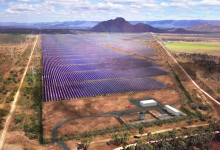Another nine large-scale solar farms in north Queensland with a total capacity of more than 712MW have been warned that their output could be cut to zero in certain circumstances due to emerging “system strength” issues in that part of the state.
The warning was made in a market notice issued by the Australian Energy Market Operator on Monday and comes on top of a previous warning that affected two solar farms and one wind farm earlier this year.
The latest to be affected are the Clare (110MW), Collinsville (42MW), Daydream (80MW), Hamilton (58MW), Hayman (58MW), Kidston (50MW), Ross River (128MW), Rugby Run (128MW), and Whitsunday (58MW) generators.
They have been told that their output could be restricted to zero if certain combinations of synchronous generators (coal, gas or hydro) are not operating at the time.
AEMO said in its market statement that the notice was issued after it and Powerlink, which operates the main transmission lines in the state, continued their investigation into system strength requirements in North Queensland. It says the new measures came into effect at 2pm on Monday.
A spokesperson for PowerLink said: “Over recent weeks generation levels at power stations in Central Queensland have been lower than usual. In response to this Powerlink – in consultation with AEMO – has modelled a range of new system strength scenarios. These scenarios are designed to maximise output from renewable generators in North Queensland, while ensuring the stability of Queensland’s power system.”
The ruling will, however, increase the level of frustration of renewable energy developers, and the tension between these developers and the transmission grid owners and market operators. Many feel that they have observed their generating performance standards but are now being faced with a hit to their output, and their revenue and earnings, because the grid in their area is not strong enough.
Five solar farms in Victoria and NSW had their output reduced by half for more than seven months after detailed modelling identified potential “voltage” issues in the West Murray region of the grid. The issue was finally resolved in April.
Earlier this month, the big Dundonnell wind farm was told it would not be able to reach full commissioning under its anticipated timeline because of new issues identified in its part of the grid. The owner, Tilt Renewables, has now flagged a significant fall in revenue and profits because of the delay.
The system strength issues in Queensland and the impact on large-scale wind and solar farms first came to a head in March, when AEMO warned that the Haughton and Sun Metals solar farms, and Mt Emerald wind farm, would be dialled back to zero under certain conditions.
None of those plants has been operating for the last few days because of those constraints. Haughton has not been allowed to generate for more than a week.
See: Two solar farms, one wind farm in Queensland hit by “system strength” issues
The variabilities are complex. In some instances, the facilities could be restricted to 50 per cent of 80 per cent of their output. In some cases they will be cut to zero.
Mostly, the generators in the area need two hydro facilities – Kareeya and Barron Gorge – to be operating all or most of their units if they are to run without interruption, although it does also depend on a combination of generating units from facilities at Callide, Stanwell and Gladstone, and it also depends on the amount of load (demand) in the local area. It is not clear how often these equations would bind.
The latest market notice affecting the additional nine solar farms identifies a number of different combinations that could affect the facilities in whole, or in part. It seems that each of these new combinations will also result in zero output at Haughton, Sun Metals and Mt Emerald even if there is partial output allowed in the other nine solar farms.
System strength issues are emerging in varying parts of the grid – even in Tasmania, despite its overwhelming dependence on hydro generation. That’s because of an increase in the number of wind farms.
System strength issues were first identified in South Australia as far back as 2017, but because there was a formal declaration of a shortfall, the market operator and the local grid owner formed a coordinated plan to address the issue, which includes the installation of four synchronous condensers, a move that will allow the number of gas generators needed at any one time to be reduced significantly.
Similar proposals are being considered by developers for the West Murray region, and presumably for north Queensland. However, until an official shortfall is declared, the response to the issue has been random and chaotic, with local grid operators requiring additional equipment from some new projects, even when a co-ordinated approach would be cheaper and more efficient.
But, as Transgrid lamented at the time, the nature of the market rules did not allow for a considered approach. Those issues are now being addressed – some of a myriad that need to be solved as the grid continues its transition. It is also one of the main reasons why AEMO favours the creation of renewable energy zones to co-ordinate generation and infrastructure investment.
PowerLink issued a call for expressions of interest into potential solutions to the system strength issues in that part of the grid in April. It said it received a strong response but won’t reveal details of its plans till December.
- In the latest Quarterly Energy Dynamics report issued by AEMO, system strength issues accounted for most of the curtailment of wind and solar in the last three months. Most of it occurred in South Australia, with an average 42MW curtailed over the three months, with Queensland averaging 5MW.












